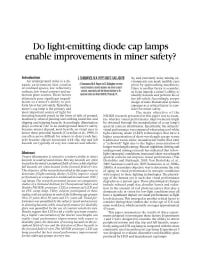Mining Publication: Do Light-Emitting Diode Cap Lamps Enable Improvements in Miner Safety?
Original creation date: October 2009
Authors: JJ Sammarco, MA Reyes, S Gallagher
Proper illumination is critical to a miner's ability to detect hazards in underground mines. Moving hazards are often located in the miner's peripheral field-of-view, while slip/trip/fall hazards are often located in the forward field-of-view. The objective of the research described in this paper was to determine if light-emitting diodes (LEDs) improve visual performance as compared to traditional incandescent (INC) cap lamps. The research presented focuses on comparative studies of a National Institute for Occupational Safety and Health (NIOSH) prototype LED, a commercial LED, and an INC camp lamp. Thirty subjects participated in these studies; ten subjects in each of the age groups: 18 to 25 years, 40 to 50 years, and 51+ years. Visual performance was quantified by the subjects' speed and accuracy in detecting hazards, while visual performance for disability glare was quantified by the use of contrast sensitivity tests. Results suggest that LEDs with a visible spectrum containing a higher concentration of the shorter wavelengths can enable visual performance improvements with respect to disability glare, the detection of moving hazards in the peripheral field-of-view, and the detection of floor hazards in the forward field-of-view. The NIOSH prototype LED cap lamp provided the best visual performance improvements for the older age groups in every test.

- Discomfort Glare Comparison for Various LED Cap Lamps
- Evaluation of Glare for Incandescent and LED Miner Cap Lamps in Mesopic Conditions
- Experiments on Personal Equipment for Low Seam Coal Miners: IV. Incorporating Coiled Cord Into Cap Lamp Battery Cords
- Mine Illumination: A Historical and Technological Perspective
- NIOSH Illumination Research Addresses Visual Performance Needs with LED Technology
- NIOSH Jupiter II Wide Area Light
- The Potential Impact of Light Emitting Diode Lighting on Reducing Mining Injuries During Operation and Maintenance of Lighting Systems
- Technological Aspects of Solid-State and Incandescent Sources for Miner Cap Lamps
- Visual Performance for Incandescent and Solid-State Cap Lamps in an Underground Mining Environment
- Visual Performance for Trip Hazard Detection When Using Incandescent and LED Miner Cap Lamps